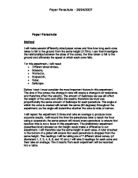By David Grocott
“How Fast Does a Paper Cone Fall?”
G.C.S.E Coursework, Physics.
Planning,
Outlining a simple procedure,
Six paper cones will be made, one with a radius of 2cm, one with a radius of 4cm, one with 6cm, one with 8cm, one with 10cm and a final one with a radius of 12cm. The cones will be made by using a compass to draw a circle on a piece of paper. According to the radius required, the compass point’s distance from the pencil will be measured and changed using a ruler. Once the circles are drawn they will be cut out and folded over themselves by a quarter of their circumference to form cones. They will be sellotaped in place, and are now ready to be dropped. A measuring tape will be attached to the wall and the cones dropped from the two meter mark of the measuring tape. The cones should be dropped facing downwards with the rim level with the two meter mark. When the cone is dropped a stopwatch will be started, the stopwatch is started by the same person who drops the cone to achieve maximum accuracy, the stopwatch is stopped the moment any part of the cone touches the ground. If the cone hits the wall or any other object on its way down, the measurement will be considered void, and that one will be re-measured. Each cone will be dropped 3 times, assuming no measurements are void. Each time a cone is dropped the time will be taken and recorded. Once all measurements have been taken and recorded successfully the experiment will be complete.
Collecting valid evidence,
To achieve accurate measurements the evidence from your experiment must be valid. The evidence collected will be valid because only one factor was changed and all others remain the same and if there is believed to be a problem with the measurement, it will be retaken. Also several measurements for each cone will be taken and an average achieved.
Use of suitable equipment and sources of evidence,
Suitable equipment is vital to a fair experiment so it is of paramount importance that the equipment used in this experiment is appropriate. The measuring tape used must be accurate and the bottom of it has to be pressed firmly to the ground ensuring the height the cones are dropped from is indeed 2m. The paper used to make the cones must be normal A4 sized and of average thickness. All cones have to be dropped from the same height and be accurately measured, ensuring the sources of evidence are suitable.
Plan of procedure,
Six paper cones are to be made, one with radius of 2cm, one with radius of 4cm, one with 6cm, one with 8cm, one with 10cm and a final one with radius of 12cm. The radius (or size) will be the one factor we are to change, during the experiment all other factors will remain the same, other wise the experiment will be unfair. The cones are made by using a compass to draw an accurate circle on a piece of paper. According to the radius required, the compass point’s distance from the pencil will be measured and changed using a ruler, i.e.-if the radius required is 2cm the distance between the compass point and the pencil will be 2cm. Once the circles are drawn they will be carefully cut out and folded over themselves by a quarter of their circumference to form cones. This measurement must be accurate or the size of our cones will change out of proportion. They will be sellotaped in place, using the same amount of sellotape each time, so that no more than one factor is changed. If too much sellotape is used it would alter the weight of the cones. Once they are taped they will be ready to be dropped. A measuring tape will be attached to the wall and the cones will be dropped from the two meter mark of the measuring tape. The cones will be dropped with the point facing downwards; this will be done because if they dropped the other way, the air currents would catch under the cone, making it unstable and more likely to hit the wall. The cones will be dropped with the rim level with the two meter mark, so the experiment is fair. The cones will be held two centimetres from the wall when being dropped, to avoid them hitting the wall. When the cone is dropped a stopwatch will be started, the stopwatch will be started by the same person who drops the cone to achieve maximum accuracy, the stopwatch will be stopped the moment any part of the cone touches the ground. If the cone hits the wall or any other object on its way down, the measurement will be considered void, and that one will be re-measured. Once one drop is complete the stopwatch will be reset ready for the next cone. Each cone will be dropped 3 times, assuming no measurements are void. Each time a cone is dropped the time will be taken and recorded. When 3 measurements for each different sized cone are taken, an average will be calculated, i.e.-the 3 times for the 2cm cone will be taken added together and divided by 3, giving an average, this will be done to provide a more accurate and realistic result. Once all averages have been successfully made the experiment will be complete.








